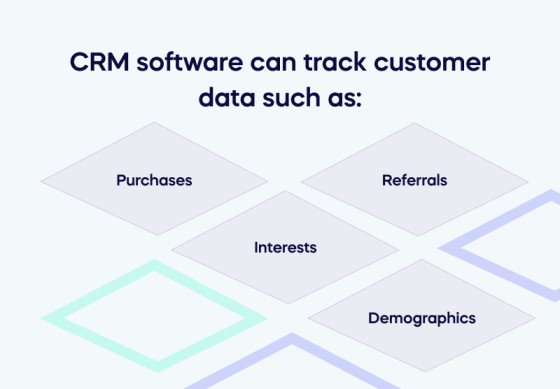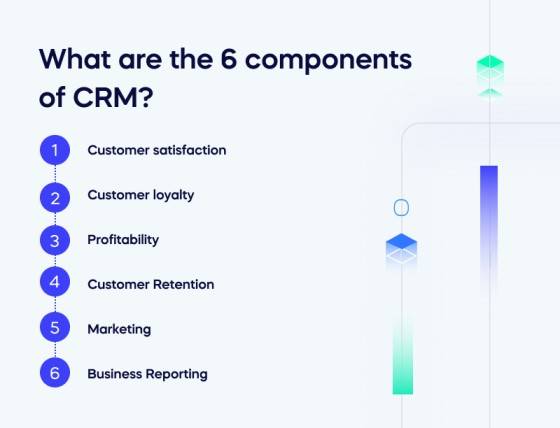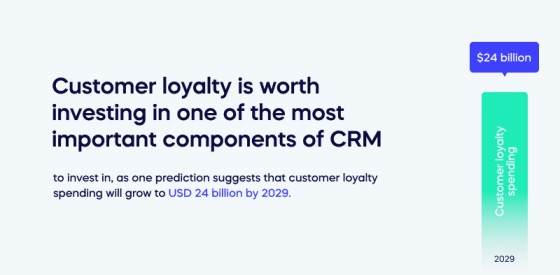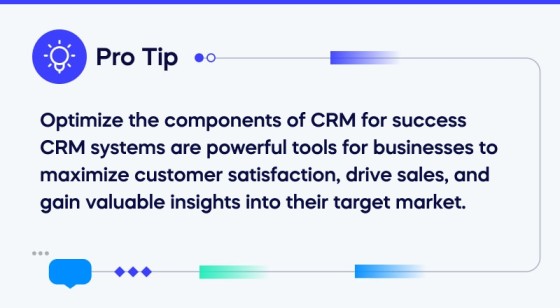Do your customers feel well-managed?
You should ask yourself this daily to ensure a close relationship throughout the customer lifecycle using the components of CRM (customer relationship management system).
In 2023, the CRM industry is currently at USD 65 billion. So, don’t get left behind by other organizations as they maintain close customer relationships for retention and high sales as they provide superior customer service.
To help you understand all the components of CRM and how they can help you maintain a strong relationship with your customers, we will explore the following topics:
- Why are the components of customer relationship management essential?
- What are the six components of CRM?
Why is Customer Relationship Management essential?
Customer relationship management is valuable for a company because it provides a straightforward way for companies to view the customer data of their client base to determine how to increase customer loyalty, profitability, and satisfaction.

CRM software can track customer data such as:
- Purchases.
- Referrals.
- Interests.
- Demographics.
The company can then use this information to make better business decisions. It can also increase the likelihood that customers will continue to purchase from the company and refer potential customers to buy from them.
At the same time, a CRM system can increase the efficiency of day-to-day operations, customer service processes, and hyperautomation to improve customer interactions and reduce wait times.
For example, it can provide customer service representatives with customer preferences, streamlining the entire support process.
Why are the components of CRM essential?
Knowing the CRM components offers an understanding of how a CRM works that you can use to ensure you get the most out of your CRM solution.
This knowledge of CRM elements helps you realize the company’s exact position of goals. Components of CRM provide business updates, making reporting a component that plays an important role.
What are the 6 components of CRM?

Understanding the six components can help you foster the most robust customer relationships. Let’s begin with the first step: satisfaction.
1. Customer satisfaction
Customer satisfaction measures a customer’s perception of the quality of a product, service, or company, incorporating product engagement and many other factors. It’s also sometimes called customer success.
Customer satisfaction is an essential component of CRM because it is a purchasing guideline for the company and the customer. If a customer is not satisfied with the result of their purchase, they are more likely to purchase from another company.
Lego increased user satisfaction by collecting and implementing user feedback within its CRM strategy.
Their LEGO Ideas website allows brick-building enthusiasts to submit their product ideas, and any suggestion that receives 10,000 votes from the community will receive consideration for production.
2. Customer loyalty
Customer loyalty is the measure of repeat sales and referrals. This measurement depends on how often a customer purchases from one particular company versus others that may be similar or better suited to their needs throughout the customer journey.
Loyal customers are more likely to be satisfied with their purchase and recommend the product to others. Thus, it is essential because it provides a consistent source of revenue for the company as product engagement has a higher success rate as customers are familiar with and satisfied with products from a specific company.
Use your CRM to offer loyalty schemes to your users, such as:
- Paid loyalty programs.
- Value-based loyalty programs.
- Points-based loyalty programs.
The loyalty program of Bodycare retailer Blume is called Blumetopia and uses a points system called Blume Bucks. Customers can earn Blume Bucks by following the brand on Instagram, placing an order, or referring friends to Blume.
3. Profitability
Profitability measures how much profit (or loss) a company makes during its operation. Calculate it by total revenue minus total costs. Profit is significant because it allows companies to continue operations and stay profitable to grow and expand.
Without profit, companies would eventually be unable to pay employees, suppliers, or taxes and eventually go out of business due to a lack of funds.
Imagine we spend $20 per year on acquiring, servicing, and selling to each customer like David, and he generates $25 in sales, then his profitability is $5.
Suppose we calculate the profitability for a larger group of customers. In that case, we can divide the total sales by the number of customers to determine the sales per customer and then calculate their profitability based on the $20 cost per customer.
4. Customer Retention
Customer retention measures how many customers remain loyal to one company over time.
Retained customers are less expensive for companies than new customers who have to go through research and development, marketing campaigns, and promotion costs all over again for new customers.
They are also more profitable for companies because they do not have to spend money acquiring them again after they have already purchased from the company once before.
One of the best examples of user retention is a robust onboarding program.
REI’s (online outdoor equipment seller) Co-op membership program is a prime example of a successful loyalty program that has resonated with customers and contributed to the company’s overall success.
While the membership cost customers money, it provided valuable benefits like store credits, exclusive gear access, and service discounts. The membership benefited REI by using marketing to reinforce the program’s perks to reduce churn and increase customer lifetime value.
5. Marketing
CRM plays a crucial role in marketing as it involves promoting and advertising your business to attract new customers. By analyzing the behaviour of potential customers, CRM helps enhance advertising strategies for greater effectiveness.
Marketing consists of different sub-components that vary depending on your business. One of the sub-components of marketing is customer service.
The purpose of CRM is to gather consumer information and use it to enhance their experience. By connecting all channels onto a single platform, CRM helps companies personalize their products and services, including personalized marketing messages.
6. Business Reporting
The final component of CRM is business reporting, which provides users with reports containing visual elements to track data over time. By comparing historical data and forecasting future performance, users can gain insights into their business operations.
Users can export data to other systems using the report function. This helps CRM users track data and make forecasts for upcoming periods.
Understanding how to create reports for CRM is crucial as reports can assist marketers and customer support departments in enhancing their processes, while also offering valuable insights to business investors regarding the company’s health and revenue trends.
The reports should be readily available and viewable from any perspective. By having the information centralized, executives can conveniently oversee multiple departments at once.
How can you use a DAP to optimize the components of CRM?
Now that you understand the components of CRM, how do you support your organization to understand them and implement them to build and maintain the best relationship with your customers?
Using a DAP (digital adoption platform) can help your staff understand the components of CRM with in-app guidance and personalized learning.
It makes it easier for staff to learn the components of CRM in their own time flexibly and integrate it into their workflow in a way that works for their time management skills and role.
A DAP reduces frustration when engaging with new topics, increasing customer loyalty as staff implement the components to make them come back for great service delivery.

Customer loyalty is worth investing in one of the most important components of CRM to invest in, as one prediction suggests that customer loyalty spending will grow to USD 24 billion by 2029.
Learning and implementing the components of CRM using a DAP is an absolute must for continuously improving customer experience and building digital resilience to compete in the marketplace.
Optimize the components of CRM for success

CRM systems are powerful tools for businesses to maximize customer satisfaction, drive sales, and gain valuable insights into their target market.
Taking advantage of all these features will allow you to create an effective strategy that increases customer satisfaction while also improving reporting, retention and profitability.
With the right approach, you’ll be able to maximize ROI from your CRM system by leveraging it as a strategic business asset rather than just another piece of software. So what are you waiting for? Optimize the components of CRM today!


